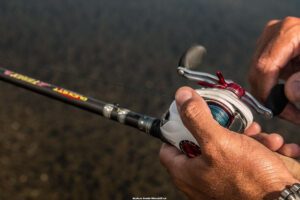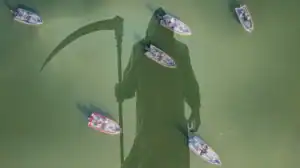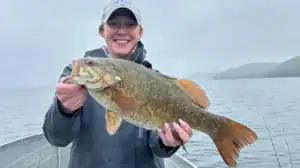It’s nearly impossible to trump the adrenaline rush of catching a bass on a topwater frog. Whether it’s the bulging wake of a pursuing bass, the braided line screeching and squeaking as it cuts through vegetation, the monster hookset that buckles your knees or the explosion itself, one thing is absolutely certain—it consumes and captivates the minds of bass anglers throughout the country.
While you can expect this popular technique to produce big catches throughout other seasons, Elite Series pro and frog fishing extraordinaire Dean Rojas believes the spring months to be a near-perfect time to capitalize on the territorial behavior of bass and fine-tune your skillset.
In order to maximize your success, however, there are several critical factors to consider.
- Spring can be the “perfect storm”
- Advantages of a frog
- Optimal shapes and colors
- Various cadences
- Hookset mechanics
- Potential hotspots
- Equipment considerations
Why a frog and why now?
After an enduring battle with Old Man Winter, bass have two things on their minds as water temperatures begin to warm—food and romance. Topwater frogs exploit these weaknesses quite effectively.
- Territorial— “When bass begin preparing for the spawn, they’re going to flock to the bank and become ornery and territorial,” Rojas said. “Both the females and males exhibit very protective behavior when they start hanging around their nests. They will stop at nothing in order to defend their beds and a topwater frog has a unique ability to coax them into striking. It’s not always a hunger strike this time of year. They simply want to eliminate a perceived threat.”
- Feeding— Although many of your springtime frog bites may stem from pure aggression, be careful not to overlook their need to feed. The spawning period can be grueling on a bass—especially females—resulting in an instinctual need to feed heavily and prepare their bodies for the rigors of the spawn. Topwater frogs can mimic substantial and nutrient-rich meals such as baby ducklings, small mice, bluegill, injured baitfish and of course, frogs.
- The magic temperature— “If I put my boat into the water in the early morning and notice a 63-degree water temperature on my Lowrance, it’s game on,” Rojas said. “At this point, the water is probably only dropping to 60 degrees overnight and warming into the 70s during the midday hours. From my experience, this is the magic window all frog fishermen need to watch for. You can do it all day long and expect awesome results.”
Advantages of a topwater frog
Aside from the sheer excitement of an aggressive topwater strike, frogs offer several advantages that allow for efficiency and high-percentage presentations when targeting shallow, spring bass.
- Weedless— Thick mats of vegetation may look impenetrable to the human eye, but that’s certainly not what a bass sees. These areas are often filled with underwater tunnels that bass use for navigation and strategic ambush points. Efficiently dissecting these areas can be near-impossible with traditional topwater lures, but this is when topwater frogs are at their best. Anglers can cast them into the thickest grass or weed beds imaginable and avoid annoying snags and hang-ups.
- Strike zone optimization— “As the spawn nears, bass aren’t always going to swim several feet to attack your offering,” Rojas said. “This often makes fast-moving presentations less desirable this time of year. Frogs, however, allow you to cast into very small, specific areas and stay in the most productive strike zone for a prolonged period. You can create a lot of commotion without moving that frog very far, which is a perfect strategy when you’re targeting spring bass.”
Shape and color selection
Similar to most bass fishing baits, there are hundreds of potential shape and color combinations to consider when choosing the best topwater frog. While it might seem overwhelming to some, Rojas has developed a two-pronged system that allows him to quickly choose the best frog for particular conditions.
The first step of his process involves the body shape.
- Pointed nose— “If I’m going to be fishing around a lot of overhanging trees, water willow and shallow grass in 2 to 4 feet of water, I’ll probably choose a pointed nose frog such as the SPRO Bronzeye 65”, Rojas said. “It really doesn’t matter if you’re fishing around Rice in Wisconsin or reeds in Alabama—this shape allows the frog to come through cover very easily. If the fish are particularly finicky and I’m noticing a lot of short strikes, I’ll downsize to a smaller Bronzeye Jr. 60 and if I’m on a lake filled with giant bass, I’ll certainly upsize to the SPRO Bronzeye King Daddy.”
- Poppers— Rojas opts for a popping frog, such as the SPRO Bronzeye Poppin’ Frog 60 when he finds himself around thick vegetation. Because it sits a bit higher in the water, it comes through mats quite well and also has a louder, more aggressive action that can “call” bass from the heavy cover.
- Gliders— “Whenever I need to fish a frog in fairly open water, I like to use a gliding frog,” Rojas said. “The SPRO Bronzeye Shad 65 sits lower in the water and has a pronounced gliding action as it walks back and forth. I reach for this model when I’m targeting riprap, wooden docks, floating docks and bluegill beds—stuff that many folks don’t consider prime frogging targets.”
Once he chooses an effective body shape, Rojas’ attention turns to color selection. He makes a concerted effort to keep the process simple in order to maximize his fishing time.
- Sunny conditions— “If you have a really bright, sunny day with bluebird skies, you’ll be better off sticking with the more natural tones,” Rojas said. “Light greens and realistic baitfish patterns are usually most productive. The bass can see very well in these conditions, so anything unnatural can spook them and really hurt your chances of catching a big one.”
- Partly cloudy conditions— Contrast becomes a big factor in Rojas’ color selection process on hazy or partly cloudy days. Instead of solid colors, he opts for darker primary colors with bright accents.
- Cloudy or lowlight conditions— “Nasty, drizzly conditions can be some of the absolute best times for stellar frog fishing,” Rojas said. “This is also when your color selection is easiest. It’s hard to go wrong by choosing any type of black pattern. Contrast isn’t too big of a deal in this situation. You’d be surprised by how effective a solid black-colored frog can be.”
Cadences to consider
Sure—you can enjoy moderate success by simply casting and twitching a topwater frog. But in order to consistently catch shallow spring bass, close attention to your retrieve cadence can pay enormous dividends.
Fortunately, it isn’t as complicated as many anglers believe it to be. Rojas primarily relies on 3 specific cadences depending on the area and mood of the bass.
- Locate ‘em— “I’ll use this retrieve when I’m exploring a body of water and searching for active bass,” Rojas said. “I work the frog very quickly with repetitive sharp, downward snaps of my rod tip. You may not catch every fish that bites when you’re working it at such a frantic pace, but you need those bass to show themselves. Keep mental notes of each blowup and you can come back a bit later and really saturate the area with a more deliberate retrieve.”
- Slow it down— If you’ve had a few bites in an area, Rojas suggests implementing occasional pauses throughout your retrieve. You’re still fishing quickly and efficiently, but the short pauses can give the bass a better opportunity to connect with your frog when they decide to strike.
- Dare ‘em— “When I finally hunker down in an area with a solid population of bass, I really slow down and put my total focus each movement of my frog,” Rojas said. “When I’m looking for active fish, I’m usually looking for my next cast as I’m retrieving the frog. But now, I’m going to soak it and make it dance on key pieces of cover. Essentially, I’m teasing and daring them to eat it. I know they’re there, I just have to irritate them into eating it. This is when it gets fun.”
Hookset mechanics
You’ve probably had this debate with your fishing buddies at some point. Once a big bass explodes on your frog, do you purposely hesitate for a half-second or set the hook right away? The conundrum has been around since the inception of frog fishing and Rojas has a definite preference.
“I hit ‘em as soon as I see ‘em,” Rojas said. “I do end up pulling it away from them at times, but that’s not always a bad thing. When they miss it, they’ll often open up a hole in the cover which gives you a specific target to make another cast towards—they’ll usually eat it again. I’d rather totally whiff on the hookset than halfway stick them and ruin my chances of fooling them again.”
A lot of things can happen when you’re setting the hook—your line can get wrapped around a pad stem, the bass can eat it upside-down and they can dislodge the frog before you even know what happened. So don’t get too upset if you swing and miss a few times throughout the day. According to Rojas, you’re doing well if you can catch 80 to 85 percent of your bites.
Potential froggin’ hotspots
Truth be told, you can expect to catch bass on a frog around any type of shallow cover throughout the spring. As Rojas earlier explained, it’s an incredibly effective presentation when the conditions align.
For the angler who wants to take their frog fishing to the next level, however, Rojas suggests a few particular hotspots that have produced for him throughout the entire country.
- Lily pad stems— “Most people fish the lively, green pad stems,” Rojas said. “But the dead ones can produce awesome frog bites in the spring. A lot of anglers overlook them, so you can potentially have a killer pattern all to yourself.”
- Flooded brush— If you’re dealing with high water levels in the spring, don’t overlook the effectiveness of a topwater frog in and around bushes. Flipping and pitching these bushes is quite popular among anglers, but a well-placed frog can give the bass a totally different look and fool some giants.
- Shallow vegetation— “Yes, it sounds a little obvious,” Rojas said. “But wherever I go, I can expect spring frog bites in shallow duckweed, alligator grass, milfoil and hydrilla. You couldn’t ask for a better froggin’ target than these types of grass.”
- Overhanging trees— Once the bass’ eggs have hatched and they begin guarding their fry, look for bushy, overhanging trees near spawning areas. The bass will go to great lengths to protect their newly hatched fry and nothing irritates them quite like a topwater frog.
Equipment considerations
Generic equipment can certainly be used for some bass fishing techniques, but frog fishing isn’t necessarily one of them. Because you’re often targeting relatively inhospitable areas, the proper gear is paramount. In order to make the most of your bites and have the ability to horse big bass out of the thick stuff, put away the spinning combos, monofilament and fluorocarbon line—it’s time to beef things up.
- Line— “You need to use braid when you’re fishing a frog,” Rojas said. “I use 80-pound Sunline FX2, which is the actual diameter of 65-pound braid. Power is essential. You have to get control of the bass immediately and get it away from the cover. Set the hook and winch them as hard and as fast as you can. If you play them at the boat, you’ll lose them. Braided line also floats and cuts through vegetation with ease, so it’s the clear choice for frog fishing.”
- Reel— Rojas is a big believer in high-speed casting reels whenever he’s using a topwater frog. He uses a 7.1:1 Duckett 360 Casting Reel in order to keep a tight line on the bass at all times. Frog-hooked bass tend to jump towards you, making a fast reel imperative to his approach.
- Rod— “Without the right rod, you will lose a lot of fish,” Rojas said. “It’s important to have a softer tip in order to absorb the shock of the frog skipping across the water. If not, you might have a difficult time with backlashes. But you also need a lot of power. I designed the 7-foot and a 7-foot, 4-inch medium heavy Duckett Terex Casting Rods specifically for frog fishing and I absolutely love them.”
When the bass get shallow this spring, make sure to have a few topwater frogs handy. Not only is it one of the most exciting ways to catch bass, but it’s also ridiculously effective. If you can follow Rojas’ guidelines and dedicate some time to it, you’ll see what all the fuss is about.














